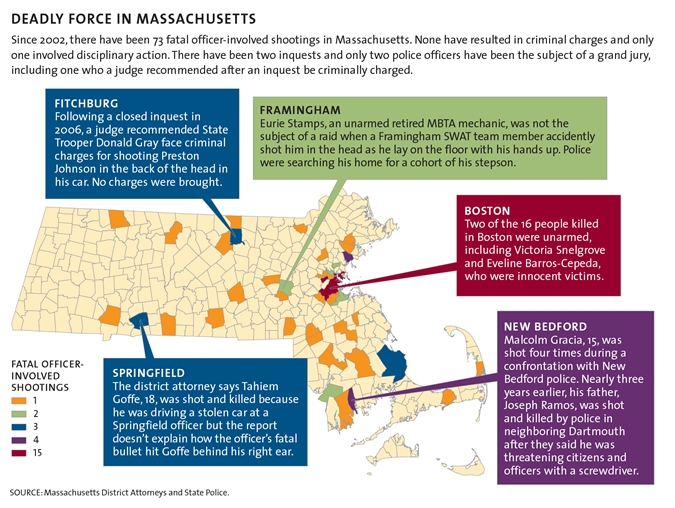Clearing the cops
Do district attorneys rubber-stamp police use of deadly force?
BY: JACK SULLIVAN
PHOTOGRAPHS BY: FRANK CURRAN AND MARK MORELLI; ILLUSTRATION BY RAFAEL RICOY
ISSUE: WINTER 2014
FROM THE TINY TOWN of Colrain at the Vermont border to the siren-pierced streets of Boston, state and local police have shot and killed 73 people across Massachusetts over the last 12 years. The deadliest year was 2013, when 12 people were killed. Every completed killing investigation found the police were justified in using deadly force; only three of the cases were presented to a grand jury or judicial inquest to determine if a crime was committed.
Most of the shootings were easy to justify. Milton police, for example, shot and killed 23-year-old Kerby Rebellus in 2009 to keep him from attacking his sister with a knife. Rebellus had already killed two other sisters, decapitating one in front of police. Suspected Boston Marathon bomber Tamerlan Tsarnaev went down in a gunfight last year with police in Watertown after allegedly killing MIT Police Officer Sean Collier and trying to escape with his brother in a stolen car filled with homemade bombs. And Dominic Cinelli was killed trading gunfire with police on the day after Christmas in 2010. Cinelli, a career criminal, had shot and killed Woburn Police Officer John Maguire after a jewelry store robbery.
But in as many as 10 of the deadly force cases, the facts of what happened are not so clear and the police motivation far more murky. In some cases, the victim did nothing wrong and just was in the wrong place at the wrong time. In others, the police initiated the confrontation and didn’t appear to take steps to avoid violence. In a few instances, the police story just doesn’t add up.
Of the 73 deadly force incidents, 29 involved people wielding guns; 23 carried a knife, hatchet, machete, sword, or box cutter; three held a pointy household item such as a pen, screwdriver, or barbecue fork; 11 drove a car in a threatening way; five others were unarmed; one had a pellet gun; and one had a starter’s gun.
In every case, the initial and primary investigation of the killing was handled by fellow police. The Boston, Springfield, and Worcester police departments investigate shootings by their officers while the State Police look into the use of deadly force in other local jurisdictions as well as by their fellow troopers. The ultimate decision on whether to prosecute is made by the local district attorney, who often works with police in his jurisdiction on a daily basis.
In a majority of the cases, the officer using deadly force claimed he fired in self-defense, fearing for his life or the life of a fellow officer. District attorneys say a claim of self-defense places the burden on the state to prove otherwise, which is difficult to do because the officer is often the only witness to the shooting and the premise that they were in fear is generally accepted as legal fact.
FULL STORY HERE:
http://www.commonwealthmagazine.org/News-and-Features/Features/2014/Winter/001-Clearing-the-cops.aspx#.VKxWOSvF-Sp

